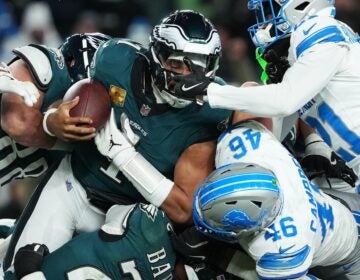Rain doesn’t dampen the Harlem Renaissance of Germantown
The rain wouldn’t have stopped her from coming.
But as Patricia Smith walked by Vernon Park on the way to the store, she was disappointed she hadn’t heard of A Great Day on the Great Road beforehand, especially after enjoying the music.
The community historical festival has been held since 2009, where the historic sites in Germantown give the public an opportunity to connect with them, said Rick Fink, education director at Cliveden of the National Trust.
Each site had representatives beneath a tent and activities such as coloring with the Johnson House, paper flowers with Awbury Arboretum and colonial games with Grumblethorpe. Also, the Germantown High School Drumline played music throughout the park and alongside Germantown Avenue as part of Fest for the Quest.
Cliveden had a lot of information about Negro Achievement Week, the week long event in April of 1928 that brought the Harlem Renaissance to Germantown.
After an article about the week was written by David Young, Cliveden executive director came out, titled “The Biggest Event of Its Kind Ever Held In Germantown,” Cliveden started working with students in Germantown High School and Germantown Friends School on a series of event, which eventually became the fest.
“The kids turned it into a neat program,” Fink said. “They put their own spin on it.”
Storyteller Denise Valentine was drawn to the event because it incorporated the Fest for the Quest, which brought W.E.B. Du Bois and James Weldon Johnson to Germantown in 1928, she said.
When she was in the main tent, she told a story about the soul of historic Philadelphia using the history of black entertainment. She knew she would have to improvise because her storytelling relies on call and response, and there were fewer people present to participate as the rain picked up.
But this wasn’t a problem for James Evans, who danced as saxophonist Tony Williams played. He was particularly entertained by Joe Becton, a Samuel D. Burris re-enactor.
The real Burris was born in Delaware and came to Philadelphia in 1823, where he became involved with abolitionist activities as a conductor of the Underground Railroad. Becton explained that people didn’t always escape to the north.
“I’m an African. I don’t like the north,” Joe Becton said in the character of Burris. “It’s cold.”
In the 1820s, they could go to Texas and in the 1830s they could go to Florida, he said.
Becton also tried to generate audience participation as he asked open questions like: “Why can’t we just…”
“Get along,” said James Evans, a Germantown resident.
Evans eventually walked to the microphone himself, having been moved by Becton’s performance.
“You can’t forget about your own people,” Evans said, as he was cheered on by Dawn Marshall, who he attended the event with. “Give it up for Samuel Burris.”
WHYY is your source for fact-based, in-depth journalism and information. As a nonprofit organization, we rely on financial support from readers like you. Please give today.




